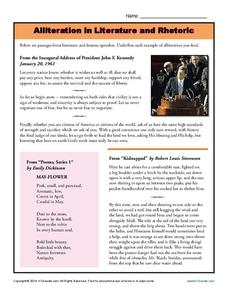K12 Reader
Winter Attack
A pack of hungry wolves surround a panicked buffalo – who will come out alive? Have your young writers narrate this nature scene, taking the point of view of either a wolf or the buffalo. Perfect for a narrative writing unit or for...
K12 Reader
What Would You Change About Your School?
Have your young writers speak their minds with a letter to the principal. Using a writing prompt at the top of the page, kids think about a change that they would like to see at their school. The prompt encourages them to consider...
K12 Reader
Mark Antony’s Oration from Julius Caesar
"And Brutus is an honourable man." Or is he? Readers of Shakespeare’s tragic Julius Caesar are asked to identify the rhetorical devices Mark Antony uses in his funeral oration and to explain how these devices influence the...
K12 Reader
Finding Text Evidence: Frederick Douglass
After reading a very brief excerpt from Frederick Douglass' autobiography, learners cite textual evidence to support a main idea of the primary source about Douglass' humiliating experience with slavery. This is a brief exercise that...
K12 Reader
Rules of the Game
Prompt your young writers to explain the rules of a game and help them develop their skills of adding appropriate detail and explanation to their writing.
K12 Reader
My "Uninvention"
Is there anything in the world you wish could be "un-invented"? If so, why would the world be a better place if your choice did not exist? Your young writers and historians will be excited to respond to this writing prompt and share...
K12 Reader
"How Do I Love Thee?" Supporting Ideas
Show your class what poem the famous line "How do I love thee? Let me count the ways" comes from. Class members read Elizabeth Barrett Browning's poem and respond to one question with a short paragraph. The question asks learners to use...
K12 Reader
Color the Spring Adjectives
Grammar enthusiasts test their adjective knowledge with a worksheet that challenges them to color each word a specific color based on the type of word that is found inside it. When complete, scholars discover a bright bouquet of flowers...
K12 Reader
Working with Figurative Language
Are your middle schoolers able to identify the literary devices featured on this worksheet? They must demonstrate their understanding of figurative language by matching the terms with their definitions and label the devices...
K12 Reader
Figurative Language: What Is It?
"Lucky lady." "Straight as an arrow." Here's a figurative language learning exercise that provides middle schoolers with six examples and asks them to identify the literary device modeled.
K12 Reader
Alliteration in Literature and Rhetoric
Middle schoolers are asked to identify the alliteration used in John F. Kennedy's Inaugural Address, Emily Dickinson's "May-Flower," and a passage from Robert Lewis Stevenson's Kidnapped.
K12 Reader
Evaluating Efficiency
There's more than one way to solve a math problem! Introduce your class to this concept with a reading passage. After reading, learners answer five related questions.
K12 Reader
Christmas Rhymes
What better way for children to celebrate the holiday season than by practicing their phonemic awareness skills? Presenting young readers with a series of eight Christmas-themed words, this worksheet asks them to circle the words...
K12 Reader
Something I'd Like to Learn
It's no secret, writing is a lot more enjoyable when it's about something we care about. This simple exercise engages children in producing original writing, while allowing them to share their personal interest with others.
K12 Reader
Find the Same Word
Assess the spelling skills of your beginning readers with a simple worksheet. Looking at a list of five CVC words, children must correctly match each one to another word with exactly the same spelling. An easy way...
K12 Reader
Choose the Correct Homophone
It's a known secret that English can be a difficult language to learn, and homophones don't make it any easier. Help your young readers tackle these tricky words with this simple fill-in-the blank exercise in which...
K12 Reader
The Great Depression
Try out this reading passage when teaching your class about the 1920s and 1930s. After reading the text, which provides an overview of some major events in these years, learners respond to five related questions.
K12 Reader
Public Education
Your pupils may not know that school was not always required. Teach them a bit about the history of public education with a reading passage and related questions.
K12 Reader
Hide and Seek
Why do certain animals look the way they do? It could be because they have developed camouflage. Kids can read up on camouflage and mimicry and then respond to five questions related to the content of the passage.
K12 Reader
Transcontinental Railroad
Who built the Transcontinental Railroad and why was it important? Your class can learn about the laying down of these tracks by reading a short passage. Pupils then respond to five questions related to the text.
K12 Reader
Fix the Story with Antonyms
Readers correct a paragraph, providing antonyms for words printed in bold print so that the paragraph makes sense.
K12 Reader
Prime or Composite?
Prime numbers? Composite numbers? Prime factorization? After reading a short article about factors and prime and composite numbers, kids answer a series of comprehension questions based on the text.
K12 Reader
Guess Who? Heroes of Civil Rights
Can your pupils identify these five important civil rights figures? Given five short descriptions, learners must match each person to his or her civil rights achievements.
K12 Reader
Civil Rights Word Scramble
Learners set these civil rights terms straight by unscrambling each group of letters. When they are finished with rediscovering their vocabulary, class members figure out what civil rights leader's name the circled letters spell.

























